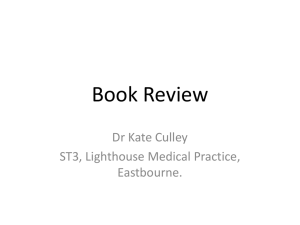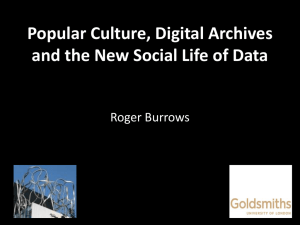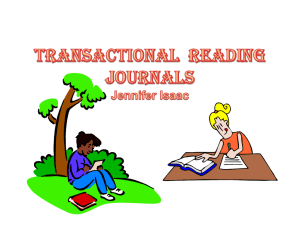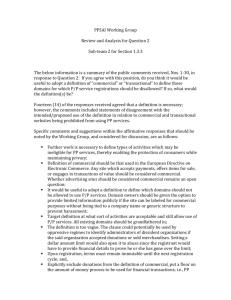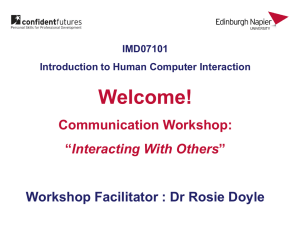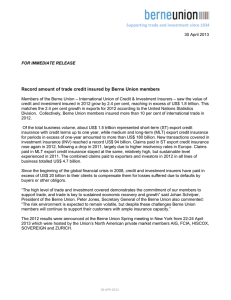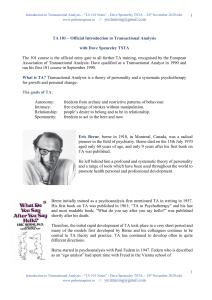Teach-Yourself-10-Ta..
advertisement
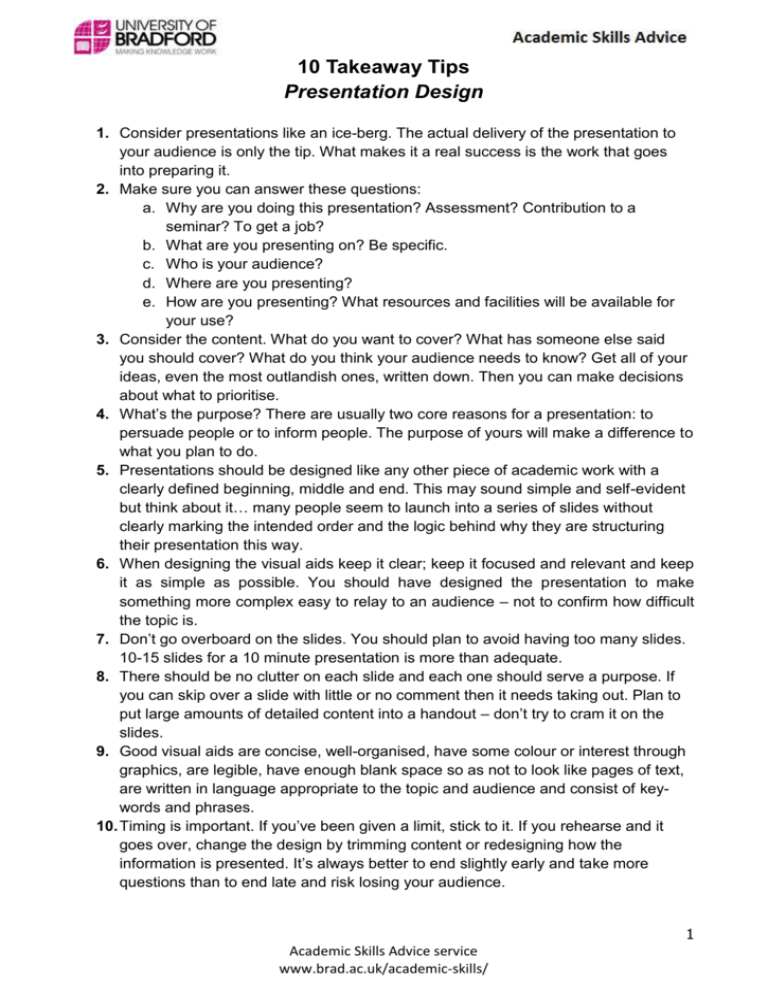
10 Takeaway Tips Presentation Design 1. Consider presentations like an ice-berg. The actual delivery of the presentation to your audience is only the tip. What makes it a real success is the work that goes into preparing it. 2. Make sure you can answer these questions: a. Why are you doing this presentation? Assessment? Contribution to a seminar? To get a job? b. What are you presenting on? Be specific. c. Who is your audience? d. Where are you presenting? e. How are you presenting? What resources and facilities will be available for your use? 3. Consider the content. What do you want to cover? What has someone else said you should cover? What do you think your audience needs to know? Get all of your ideas, even the most outlandish ones, written down. Then you can make decisions about what to prioritise. 4. What’s the purpose? There are usually two core reasons for a presentation: to persuade people or to inform people. The purpose of yours will make a difference to what you plan to do. 5. Presentations should be designed like any other piece of academic work with a clearly defined beginning, middle and end. This may sound simple and self-evident but think about it… many people seem to launch into a series of slides without clearly marking the intended order and the logic behind why they are structuring their presentation this way. 6. When designing the visual aids keep it clear; keep it focused and relevant and keep it as simple as possible. You should have designed the presentation to make something more complex easy to relay to an audience – not to confirm how difficult the topic is. 7. Don’t go overboard on the slides. You should plan to avoid having too many slides. 10-15 slides for a 10 minute presentation is more than adequate. 8. There should be no clutter on each slide and each one should serve a purpose. If you can skip over a slide with little or no comment then it needs taking out. Plan to put large amounts of detailed content into a handout – don’t try to cram it on the slides. 9. Good visual aids are concise, well-organised, have some colour or interest through graphics, are legible, have enough blank space so as not to look like pages of text, are written in language appropriate to the topic and audience and consist of keywords and phrases. 10. Timing is important. If you’ve been given a limit, stick to it. If you rehearse and it goes over, change the design by trimming content or redesigning how the information is presented. It’s always better to end slightly early and take more questions than to end late and risk losing your audience. 1 Academic Skills Advice service www.brad.ac.uk/academic-skills/ Have a Go! Try turning this wordy information into visual aids for a presentation. The catch is you MUST only use a maximum of 5 slides. Make sure there is a clear beginning, middle and end to your mini-presentation and that you select only the information which you feel is truly necessary to provide a brief description of Transactional Analysis. A Brief Description of Transactional Analysis (TA) In his early work Berne himself perceived his theory to consist of two strands, those of structural analysis and transactional analysis. However, his theories were not generated as a complete and finite whole (Stewart 1992: 17); by the time Berne wrote Transactional Analysis in Psychotherapy he had begun to use the term ‘transactional analysis’ to “…refer to the whole system, including structural analysis” (Berne 1961: 12). Therefore, to clearly define TA, structural analysis and transactional analysis must be understood separately before being taken as complementary and inseparable elements of one theory. Transactional Analysis has continued to grow and change since Berne first used it as psychiatric intervention. As a wider body of knowledge, TA is now used for a variety of purposes outside of psychiatry; it has flourished as a resource for personal development; a theory of personality; a theory of social communication and a modality of psychotherapy. (Whether this is to promote organisational, group or individual well-being and change.) TA can now be found widely used as a method of improving business dynamics and improving productivity and effectiveness in the workplace. This is evidenced by the large number of websites advertising business consultancies using TA principles and the marketing of training such as TA101 as being ideal for HR and Careers Advisers. This is often as an organisational (or systemic) application of TA principles. However, here we see the importance of Berne’s distinction between structural analysis and transactional analysis within TA. In the writer’s experience it is the structural model which is neglected or misunderstood or simply not included: as if TA were simply transactional analysis using the functional model. It is this which appears to be most often drawn upon in the business world as a means of understanding and changing the inner workings of an enterprise. TA is also effective as a way to promote and sustain non-therapeutic personal change. The writer’s experience of this is in the field of life-coaching. Here, it is not designated as a ‘counselling approach’ as this would be unethical, given the boundary considerations around the role of the coach. Instead, it is easily employed to explore and express a client’s motivational drives. It is also useful when examining a client’s tendency to selfsabotage through work on discounting and rackets. Berne, E. (1961) Transactional Analysis in Psychotherapy, London: Souvenir Press. Stewart, I. (1992) Eric Berne, London: Sage Publications. 2 Academic Skills Advice service www.brad.ac.uk/academic-skills/
